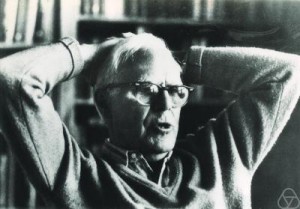Skeptic Martin Gardner Dies
Posted by: Loren Coleman on May 23rd, 2010

Martin Gardner, 95, well-known in skeptical and debunking circles, died on May 22, 2010, in Norman, Oklahoma.
Martin Gardner (October 21, 1914 – May 22, 2010) was an American mathematics and science writer specializing in recreational mathematics, but with interests encompassing micromagic, stage magic, pseudoscience, literature (especially the writings of Lewis Carroll), philosophy, scientific skepticism, and religion. He wrote the “Mathematical Games” column in Scientific American from 1956 to 1981, and published over 70 books.
Gardner’s uncompromising attitude toward pseudoscience made him one of the world’s foremost anti-pseudoscience polemicists of the 20th century. His book Fads and Fallacies in the Name of Science (1952, revised 1957) is a classic and seminal work of the skeptical movement. It explored a myriad of dubious outlooks and projects including Fletcherism, creationism, organic farming, Charles Fort, Rudolf Steiner, Scientology, Dianetics, UFOs, dowsing, extra-sensory perception, the Bates method, and psychokinesis. This book and his subsequent efforts (Science: Good, Bad and Bogus, 1981; Order and Surprise, 1983) earned him a wealth of detractors and antagonists in the fields of “fringe science” and New Age philosophy with many of whom he kept up running dialogs (both public and private) for decades.
In 1976, Gardner was a founding member of the Committee for the Scientific Investigation of Claims of the Paranormal (CSICOP), and he wrote a column called “Notes of a Fringe Watcher” (originally “Notes of a Psi-Watcher”) from 1983 to 2002 for that organization’s periodical Skeptical Inquirer. These have been collected in five books: New Age: Notes of a Fringe Watcher (1988), On the Wild Side (1992), Weird Water and Fuzzy Logic (1996), Did Adam and Eve Have Navels (2000), and Are Universes Thicker than Blackberries (2003). Gardner was a senior CSICOP fellow and prominent skeptic of the paranormal.
In addition to his expository writing about mathematics, Gardner was an avid controversialist on contemporary issues, arguing for his points of view in a wide range of fields, from general semantics to fuzzy logic to watching TV (he once wrote a negative review of Jerry Mander’s book Four Arguments for the Elimination of Television). His philosophical views are described and defended in his book The Whys of a Philosophical Scrivener.
Gardner was well known for his sometimes controversial philosophy of mathematics. He wrote negative reviews of The Mathematical Experience by Philip J. Davis and Reuben Hersh and What is mathematics, really? by Hersh, both of which were critical of aspects of mathematical Platonism, and the first of which was well-received by the mathematical community. While Gardner was often perceived as a hard-core Platonist, his reviews demonstrated some formalist tendencies. Gardner maintained that his views are widespread among mathematicians, but Hersh has countered that in his experience as a professional mathematician and speaker, this is not the case.

Martin Gardner grew up in and around Tulsa, Oklahoma, and he attended college at the University of Chicago, where he earned his bachelor’s degree in philosophy. During World War II, he served for several years in the U.S. Navy as a yeoman (the ship’s secretary) on board the destroyer escort USS Pope (DE-134) in the Atlantic, as Gardner states several times in his writings. His ship was still in the Atlantic when the war came to an end with the surrender of Japan in August 1945.
After the war, Gardner attended college at the University of Chicago again. He also attended graduate school for a year there, but he did not earn an advanced degree.
For many decades, Gardner, his wife Charlotte, and their two sons lived in Hastings-on-Hudson, New York, where he earned his living as an independent author, publishing books with several different publishers, and also publishing hundreds of magazine articles and newspaper articles in various magazines and newspapers. Either by choice or coincidence (given his interest in logic and mathematics), they lived on Euclid Avenue. In 1979, he and his wife semi-retired and moved to Hendersonville, North Carolina. His wife died in 2000.
In the early 1950s, he was editor of Humpty Dumpty Magazine, and wrote features and stories for several children’s magazines. His paper-folding puzzles at that magazine (sister publication to Children’s Digest at the time, and now sister publication to Jack and Jill Magazine) led to his first work at Scientific American.
In 2002 Gardner returned to Norman, Oklahoma, where his son, James Gardner, is a professor of education at the University of Oklahoma.
About Loren Coleman
Loren Coleman is one of the world’s leading cryptozoologists, some say “the” leading living cryptozoologist. Certainly, he is acknowledged as the current living American researcher and writer who has most popularized cryptozoology in the late 20th and early 21st centuries.
Starting his fieldwork and investigations in 1960, after traveling and trekking extensively in pursuit of cryptozoological mysteries, Coleman began writing to share his experiences in 1969. An honorary member of Ivan T. Sanderson’s Society for the Investigation of the Unexplained in the 1970s, Coleman has been bestowed with similar honorary memberships of the North Idaho College Cryptozoology Club in 1983, and in subsequent years, that of the British Columbia Scientific Cryptozoology Club, CryptoSafari International, and other international organizations. He was also a Life Member and Benefactor of the International Society of Cryptozoology (now-defunct).
Loren Coleman’s daily blog, as a member of the Cryptomundo Team, served as an ongoing avenue of communication for the ever-growing body of cryptozoo news from 2005 through 2013. He returned as an infrequent contributor beginning Halloween week of 2015.
Coleman is the founder in 2003, and current director of the International Cryptozoology Museum in Portland, Maine.









